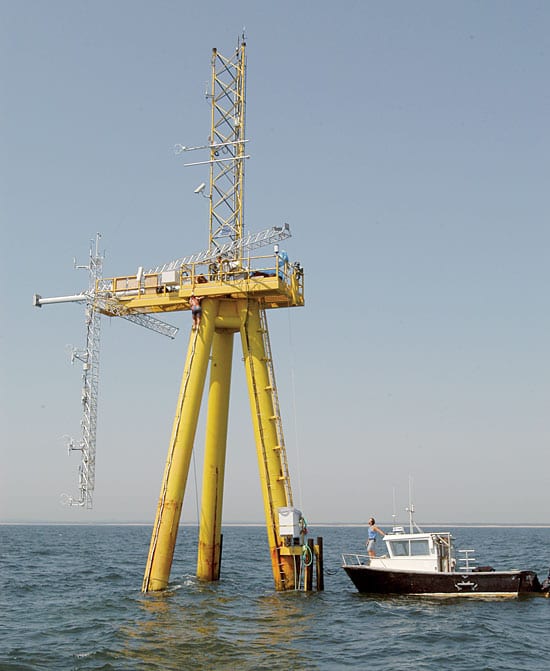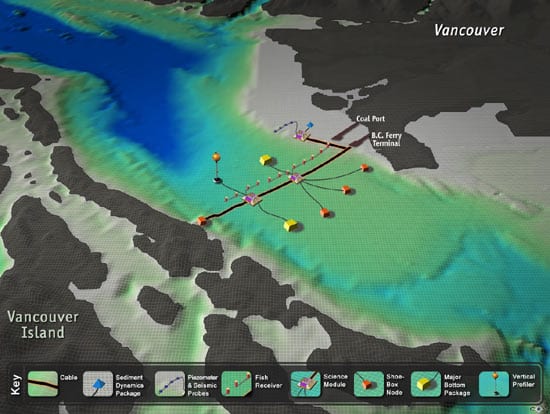Coastal Observatories and Observing Systems
Through a combination of cabled systems and underwater nodes, moorings, buoys, and other observing platforms, scientists are monitoring the coastal environment and exploring the fundamentals of ocean processes on the continental shelf.
Cabled Coastal Observatories
Martha’s Vineyard Coastal Observatory
Established in 2000 by the Woods Hole Oceanographic Institution, MVCO provides a natural laboratory to study key coastal processes in the North Atlantic Ocean. Studies have examined the exchange of heat and water between the ocean and atmosphere; how ocean properties affect blooms of ocean plants and animals; how military mines are covered and uncovered by sediment transport; and how bubbles and turbulence affect the propagation of sonar and other sound signals.
» Visit website
» Read an article from Oceanus Magazine about MVCO
VENUS - Victoria Experimental Network Under the Sea
Now being installed by Canadian researchers and their American partners, VENUS is a network of cabled instruments to observe the waters off the coast of Vancouver. A four-kilometer array in Saanich Inlet will focus on inlet renewal, ocean chemistry, biological interactions among species, and system design development of seafloor observatory components. A major line will cross the Strait of Georgia will support instruments to measure water properties, river dynamics, whale acoustics, fish migrations, and plankton distribution. A spur line along the Fraser Delta front will support a project to monitor the stability of the delta sediments.
» Visit website
Long-term Ecosystem Observatory
Established in 1994 by Rutgers University (with assistance from Woods Hole Oceanographic Institution), LEO-15 was the first cabled coastal observatory. Situated off Tuckerton, N.J., the observatory has served as a testbed for many coastal observing techniques and tools.
» Visit website
» Read an article from Oceanus Magazine about LEO
Panama LJL Underwater Tropical Observatory
PLUTO is a cabled observatory deployed by Woods Hole Oceanographic Institution researchers in January 2006 in 18 meters of water near the Liquid Jungle Laboratory (LJL). It is the first part of a plan to build to observe biological systems from the tree canopy and jungle floor to the mangrove swamps and ocean floor.
» Visit website
» Read an article from Oceanus Magazine about PLUTO
Polar Remote Interactive Marine Observatory
PRIMO is a cabled observatory scheduled to be deployed in 2006 by Woods Hole Oceanographic Institution researchers. The seafloor node will be situated in a 130-meter deep channel about 3 miles south of Palmer Station, Antarctica.
» Visit website
» View data from the observatory
» Read an article from Oceanus Magazine about preparations made for the observatory
Coastal Observatory Research Arrays
The Coastal Ocean Processes (CoOP) program is an interagency effort (NSF, NOAA, and ONR) to conduct large-scale, interdisciplinary research to improve our understanding of the processes that dominate the transport, transformation, and fates of biologically, chemically, and geologically important matter in the coastal zone and along the continental margin.
Observing Systems Using Buoys, Moorings, and other Platforms
Coastal Observing Systems Clearinghouse
A National Oceanic and Atmospheric Adminstration site linking all of the private and government-sponsored observing platforms and projects in North America.
Eastern Consortium of Coastal Ocean Observatories
Ocean research institutions on the U.S. East Coast are collaborating to turn their individual observatories into a wider network.
Gulf of Maine Ocean Observing System
Collaborative of nearly 40 research laboratories, insitutions, government agencies, and private companies in New England to bring hourly oceanographic data from the Gulf of Maine to all those who need it.
»Visit website
New Approaches for Coastal Observatories
The U.S. Geological Survey and Woods Hole Oceanographic Institution--in cooperation with the U.S. Coast Guard, the Massachusetts Water Resources Authority, and RD Instruments--are developing a low-cost system for retrieving oceanographic data from instruments in the coastal ocean.
»Visit website
SouthEast Atlantic Coastal Ocean Observing System
SEACOOS is a collaborative university partnership that collects, manages, and disseminates integrated, regional ocean observations and information products for North Carolina, South Carolina, Georgia, and Florida.
»Visit website
Chesapeake Bay Observing System
CBOS provides real-time data on the bay while chronicling long-term changes in the region.
»Visit website
Southern California Coastal Ocean Observing System
SCCOOS brings together coastal observations along the Southern California Bight to address issues in coastal water quality, marine life, and coastal hazards.
»Visit website
Sargasso Sea Ocean/Atmosphere Observatory
Led by the Bermuda Biological Station for Research, S2O2 is being formed by several institutions to coordinate marine biological, biogeochemical, hydrographic, and atmospheric studies in the western North Atlantic.
See Also
Building an Automated Underwater Microscope
A conversation with Heidi Sosik, science director of the Martha's Vineyard Coastal Observatory



